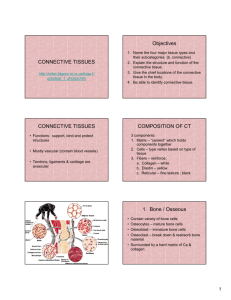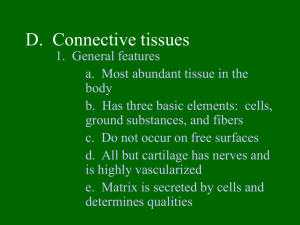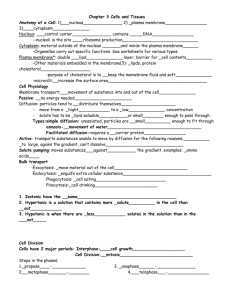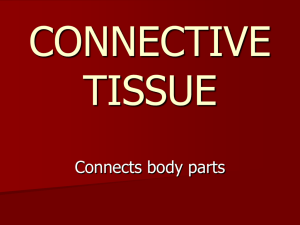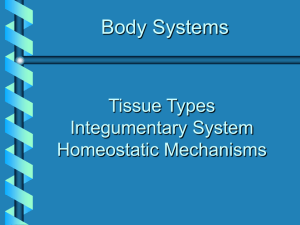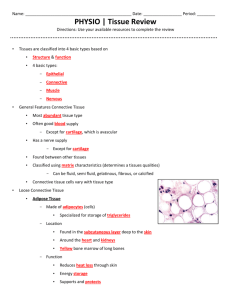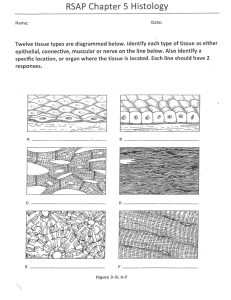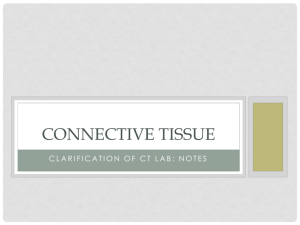File
advertisement
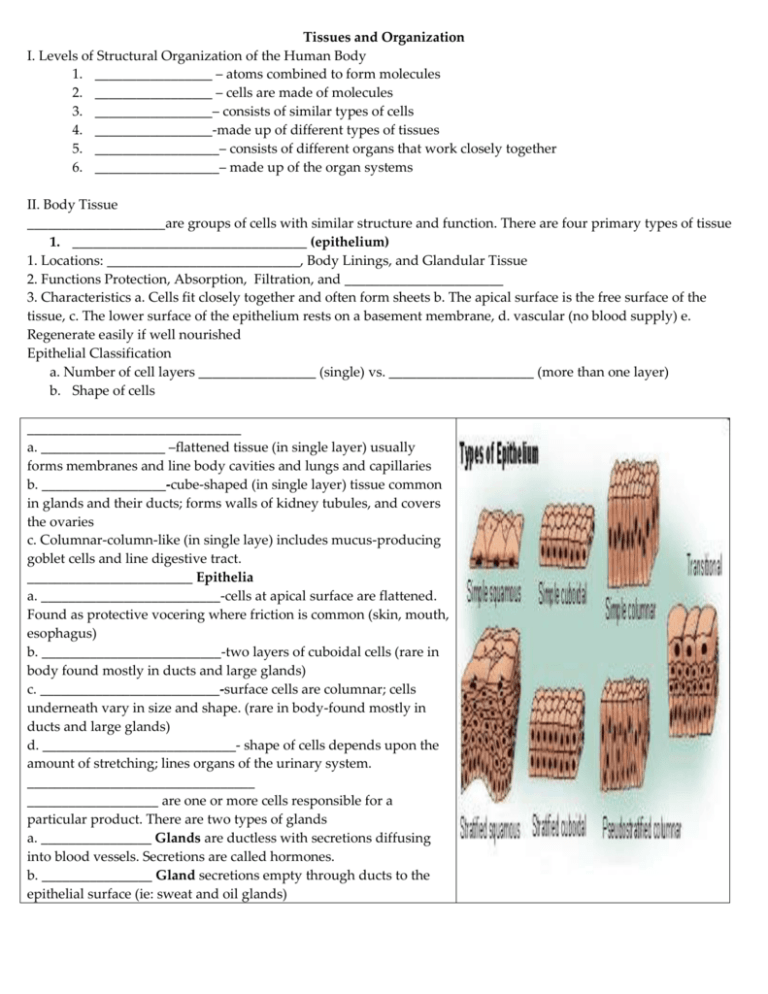
Tissues and Organization I. Levels of Structural Organization of the Human Body 1. _________________ – atoms combined to form molecules 2. _________________ – cells are made of molecules 3. _________________– consists of similar types of cells 4. _________________-made up of different types of tissues 5. __________________– consists of different organs that work closely together 6. __________________– made up of the organ systems II. Body Tissue ____________________are groups of cells with similar structure and function. There are four primary types of tissue 1. __________________________________ (epithelium) 1. Locations: ____________________________, Body Linings, and Glandular Tissue 2. Functions Protection, Absorption, Filtration, and _______________________ 3. Characteristics a. Cells fit closely together and often form sheets b. The apical surface is the free surface of the tissue, c. The lower surface of the epithelium rests on a basement membrane, d. vascular (no blood supply) e. Regenerate easily if well nourished Epithelial Classification a. Number of cell layers _________________ (single) vs. _____________________ (more than one layer) b. Shape of cells _______________________________ a. __________________ –flattened tissue (in single layer) usually forms membranes and line body cavities and lungs and capillaries b. __________________-cube-shaped (in single layer) tissue common in glands and their ducts; forms walls of kidney tubules, and covers the ovaries c. Columnar-column-like (in single laye) includes mucus-producing goblet cells and line digestive tract. ________________________ Epithelia a. __________________________-cells at apical surface are flattened. Found as protective vocering where friction is common (skin, mouth, esophagus) b. __________________________-two layers of cuboidal cells (rare in body found mostly in ducts and large glands) c. __________________________-surface cells are columnar; cells underneath vary in size and shape. (rare in body-found mostly in ducts and large glands) d. ____________________________- shape of cells depends upon the amount of stretching; lines organs of the urinary system. _________________________________ ___________________ are one or more cells responsible for a particular product. There are two types of glands a. ________________ Glands are ductless with secretions diffusing into blood vessels. Secretions are called hormones. b. ________________ Gland secretions empty through ducts to the epithelial surface (ie: sweat and oil glands) 2. _______________________ is found everywhere in the body. Includes the most abundant and widely distributed tissues. Connective tissue functions to bind body tissue together, support the body, and provide protection. Some connective tissue is well vascularized, while some have poor blood supply or are avascular. The _______________________ is the non-living material that surrounds living cells. It consists of two main elements: a. ____________________-mostly water along with adhesion proteins and polysaccharide molecules. b. Fibers that are produced by cells. The three types include: _________ (white) fibers, ___________ (yellow) fibers, and _____________-fine fibers that form the skeleton of soft organs like the spleen. Types of Connective Tissue: 1. _______________ (osseous tissue) Composed of Bone cells in lacunae (cavities), a hard matrix of calcium salts, and a large numbers of collagen fibers. Bone is used to protect and support the body. 2. _______________________- the most common type of cartilage. It is composed of abundant collagen fibers and a rubbery matrix. It is located in the larynx and the entire fetal skeleton before birth. 3. __________________________ which provides elasticity. Elastic cartilage is supports the external ear. 4. ________________________ is highly compressible and forms the cushion-like discs between vertebrae 5. ___________________________ (dense fibrous tissue). The main matrix element is collagen fiber with rows of Fibroblasts (fiber-forming cells). This tissue makes up i. _________________—attach skeletal muscle to bone ii. _________________—attach bone to bone at joints iii. _________________—lower layers of the skin 6. Loose connective tissue types-softer connective tissue a. _________________________ the most widely distributed connective tissue, which consists of soft, pliable tissue like “cobwebs”. Areolar tissue functions as a packing tissue and contains all fiber types. Sometimes this tissue can soak up excess fluid (causes edema) b. __________________________ an areolar tissue in which fat globules predominate. Many cells contain large lipid deposits, which function to insulate the body, protect some organs, and serves as a site of fuel storage c. ___________________ connective tissue consists of a delicate network of interwoven fibers. This tissue forms stroma (internal supporting network) of lymphoid organs. It is found in lymph nodes, the spleen, and bone marrow 7. __________________ (vascular tissue) consists of blood cells surrounded by fluid matrix called blood plasma. The fibers are visible during clotting. Blood functions as the transport vehicle for materials 3. Tissue Repair and Healing • _________________________ – Replacement of destroyed tissue by the same kind of cells • _________________________ – Repair by dense (fibrous) connective tissue (scar tissue) • _________________________ – Type of tissue damaged – Severity of the injury Process • ______________________ become very permeable – Introduce clotting proteins – A clot walls off the injured area • Formation of ________________________________ – Growth of new capillaries – Rebuild collagen fibers • Regeneration of surface __________________________ • • – Scab detaches Tissues that regenerate easily – Epithelial tissue (skin and mucous membranes) – Fibrous connective tissues and bone Tissues that regenerate poorly – Skeletal muscle • Tissues that are replaced largely with scar tissue – Cardiac muscle – Nervous tissue within the brain and spinal cord

